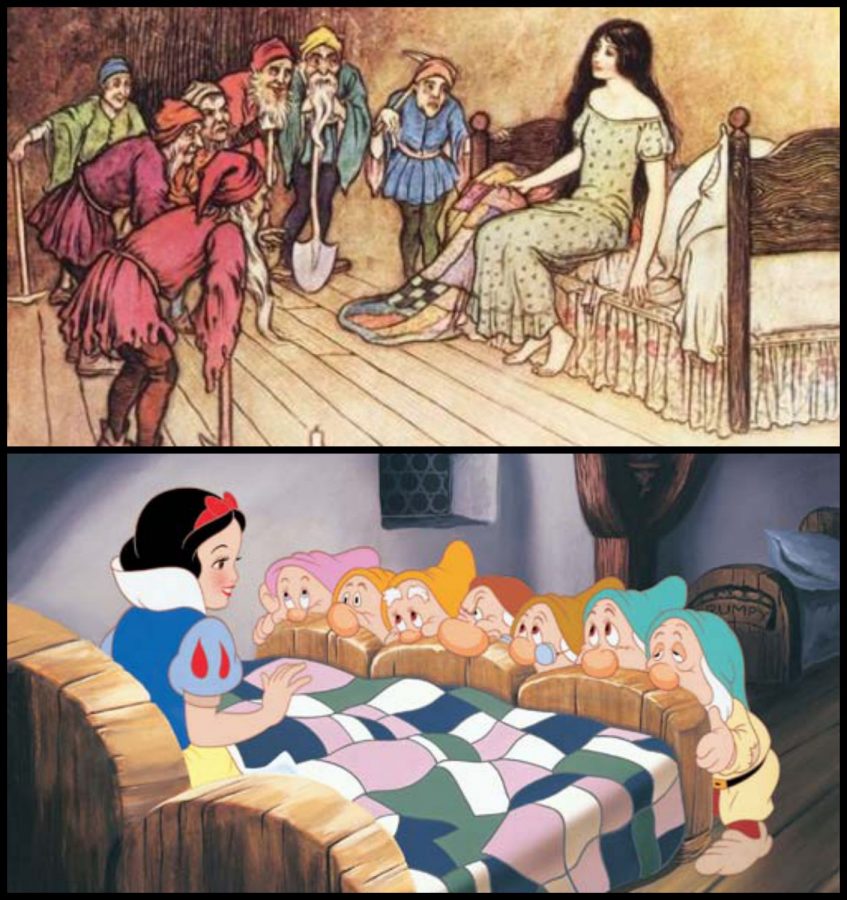Grimm’s Fairy Tales: The Gruesome Roots of Modern Fables
December 5, 2018
Everyone gets a happy ending, right? Not necessarily. If you’ve ever read Grimm’s Fairy Tales then you know that is usually not the case. Sometimes the prince doesn’t get the princess, the frog stays a frog, and the palace of sunshine and rainbows is really the fortress of death and knives.
Okay, maybe I was exaggerating a little with that last one but truly things are rarely as they seem in these grisly Grimm tales. Allow me to introduce you to an unfiltered version of Cinderella, or as she was originally known, Ashputtel.
Ashputtel was far from the locked up little servant girl that Disney portrays Cinderella as. When things didn’t go her way, she simply chanted a magic spell to her bird friend or the hazel tree in her backyard grown from her tears and things got sorted out. For example, when she wanted to go to the ball, she stood beneath her hazel tree and asked it for a golden dress and, Voila! Not exactly a fairy godmother but if it works, why fix it?
The stepsisters were also another story. Their feet did fit the shoe. But not because Cindy and “The Steps” were all a size seven. In the Grimms version of the story, the stepmother forces her daughters to cut off pieces of their feet. One girl chops off her heel and the other her toe in a gory attempt to capture the prince’s heart and throne.
Fortunately for Ashputtel (or Cinderella as we know her), her bird buddy calls out to the prince as he passes the enchanted tree and lets him know that he is being tricked. When he sees the shoe filled with blood, he realizes he’s been duped and goes back to find his true bride Ashputtel.
Another twisted tale that has been warped by time is Hansel and Gretel. In the original Hansel and Gretel, the children were abandoned by their parents in the forest while they were sleeping. The family is living in extreme poverty and the solution the parents find is to simply rid themselves of the two youngest mouths. The children overhear their parents plotting and manage to thwart their first attempt at abandonment.
Sadly, they are unable to escape the second effort, and they soon find themselves in the company of the candy house witch. Now, this witch does absolutely nothing to conceal cannibalistic tendencies. In fact, she’s so blase about it, it’s kind of ridiculous. She outright tells Gretel that she wants to “slaughter and boil” her brother.
The story is quite gruesome. I won’t go into too much detail, but it definitely has been sugar coated (no pun intended) throughout the years. In the end, though, the children make it home and are welcomed with open arms. This is partly because the witch’s house was not only made of gingerbread but also conveniently filled with an abundance of riches.
There are plenty more stories like these. I highly recommend you check out the Grimms Brothers Fairy Tales if you haven’t already read them. They are a wonderfully gritty breath of fresh air from the ridiculously happy endings that we are spoon fed from birth.
Check out Ashputtel and Hansel and Gretel below!
https://www.pitt.edu/~dash/grimm015.html
http://etc.usf.edu/lit2go/175/grimms-fairy-tales/3104/ashputtel/



Stephanie Jimenez • Dec 6, 2018 at 10:28 am
Amazing!!!